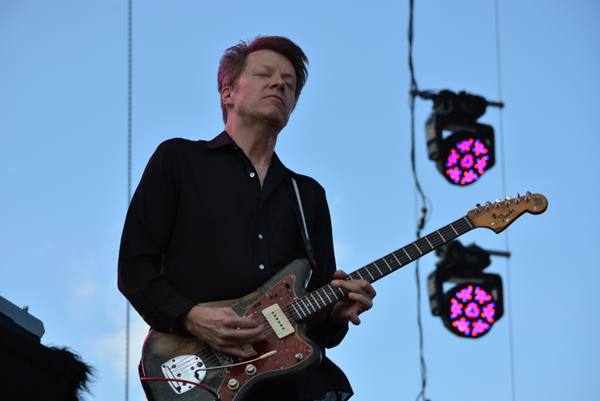
Photo by Dean Budnick
Nels Cline may be best known as the wild axeman flanking the likes of Jeff Tweedy, Glenn Kotche and John Stirratt (among others) in Wilco, but with Cline’s latest solo output Lovers, he completes a mission started long before joining up with the Chicago indie mainstays.
It’s hard to call Lovers a “solo” album, as Cline enlisted a slew of close friends to bring the album, which he says has been living inside his head for the better part of 30 years. The album touches on many of Cline’s favorite compositions, highlighted by an instrumental arrangement of Sonic Youth’s “Snare, Girl.”
As Cline explains at length, Lovers is a project decades in the making and has adapted itself to Cline’s current self with the experiences and influences he has gained along the way incorporated into the final product. This, of course, all also coincides with Wilco’s newest effort Schmilco, which he also touches on.
One of the themes in this record is the concept of “mood music.” What does that mean to you and what are you trying to evoke from the listener when you make this type of music?
I think that in a way, me describing Lovers as potential mood music is a bit of me being unrealistic about the fact that it is actually an engaging and dynamic attempt. But the inspiration initially was derived from not just what was called mood music records in the ‘60s, which were often orchestral records made by musicians doing revamped versions of hit instrumentals of the day and there were many in those days, so like the love scene from The Sandpiper, or the “Baby Elephant Walk” by Mancini from Hatari!. Those kinds of things.
But also the romance kind of jazz records of the day, whether it was Ben Webster For Lovers or Stan Getz’s Focus, or whatever. We refer to these things generally as mood music because they’re pretty much soft around the edges and can be listened to or ignored, depending, and that way there are early versions of what we now refer to as ambient music, I suppose, something to create an atmosphere and at their best, are engaging listening, and at their worst, I guess they’re just background music.
I just thought many, many years ago, that it would be interesting, because I like some of these kinds of records, but also I thought it would be interesting to add more darkness, more shadows, and more edge to this idea and make the notion of romance possibly more thorough or more realistic. Hence the conclusion of pieces like the theme from The Night Porter for example, or “Touching” by Annette Peacock, which is not necessarily dark but certainly abstract.
That said, the years passed, the project sort of became, in some ways, more of a jazz record in some regards, and then also it’s just a little more upbeat, and it’s a little more groovy, so I don’t know if it’s really a mood music record anymore.
Mood music sounds like a concept that has certainly evolved over the years, particularly now that you mention what we now know as ambient music.
In my case I was thinking more about the kind of thing that—the super groovy bachelor puts on whatever record on his KLH stereo and mixes the martini and sits a little too close to his date on the couch and hopes for the best.
You mentioned you’ve had this idea for a while. How does the final product compare to how it was first conceived in your head and how has it adapted itself over the years?
For one thing I was going to always do all of the arrangements, but I became more and more daunted by this idea, especially as the record was leaning more towards traditional jazz arrangements and also I was becoming a bit perplexed as to how to arrange my own pieces and realized that I didn’t really have the expertise to make those sound anything possibly beyond interesting, or beyond traditional.
Beyond that, the songs that were originally on my ever-changing list that made it to the record from the earliest conceptualizing are “Cry, Want” by Jimmy Giuffre, the theme from The Night Porter, “The Search For Cat”, the queue from Breakfast at Tiffany’s by Henry Mancini, “Touching” by Annette Peacock, and “Secret Love”. Other songs that came slightly later were pieces like, “Beautiful Love”; I had the piece “Diaphanous” which is the second piece after the introduction on the record of mine from the very beginning, but the other pieces I had written had gone by the wayside.
Some things were added really at the last minute and really in the eleventh hour just because I wanted the program to be maybe a little more balanced because it’s got a ballad-heavy concept and also I wanted some of the musicians because it’s this incredible group of musicians and they’re basically just having to play parts while I have all the fun. I wanted them to be able to participate a little bit more and have their voices emerge, so “Lady Gabor” was added very late in the game, also because I wanted a grooving drone piece besides “Snare, Girl.” My piece, “The Bed We Made,” which didn’t have a title when we recorded it, was a late addition; I had just finished writing the piece, and had asked Michael Leonhart what he thought, if he thought it would fit in the program, and he said, “Yeah, let’s do it.” That’s a little bit more of an up, ¾ number, and then the piece called the “The Bond,” it concludes the record, wasn’t an eleventh hour addition but when I realized I would love to have an orchestrated version of that song on the record, then I knew how the record was going to end, because that piece has this definitive quality that I perceived right away when Julian Lage and I started playing it as a duo, which is how I first conceived the piece, and that’s how we would always end our concerts. I figured, “Hey, we’re going to end the record with this piece,” which means the record is not going to be as dark and I guess as brooding and ponderous as I thought about it in the ‘80s on a nice quiet G major chord.
You mentioned the large cast of musicians on the record. What were you looking for when recruiting people for this album?
Well besides wanting to involve some of my favorite people, almost all of them live in New York here where I live, not where I was living when I was conceiving the album.
I wanted to have a palette, and this was something I discussed with Michael Leonhart and he basically said, “Please let me help you with this,” and I told him, because I wanted almost no saxophone on the record, I wanted the palette to be heavy on alto or bass, flutes, and clarinets of various stripes, with Ben Goldberg on bass clarinet, and muted brass, and bassoon. Michael added Charles Pillow to the ensemble, who also plays double reeds, oboe, and English horn, which I had not included in my thoughts and I’m very glad he did.
I thought that would be a unique sonic palette and also Michael termed it ‘minimal lush,’ that’s what he likes to call what he felt his directive was.
I had very, very specific ideas arranging-wise for the pieces that were on the song list from the very beginning, so something like “Cry, Want” with the marimba and the bass flute and all of that, was basically how I heard it and Michael nailed it. The heartbeat on, what I call the chord cluster heartbeat, on “Secret Love” which is in 5/8 against the 4/4, and the re-harmonization of the bridge was my idea but basically I would give Michael only sketches and lead sheets and things like that and then we would just verbally discuss what I wanted and other songs like “The Bed We Made,” for example, which I mentioned, I had just told to him to do whatever he wanted and I didn’t hear the arrangements until we were recording because there’s no way to convene a whole 17-23 piece group just to test your arrangements. It’s extremely expensive and extravagant. So only a few revisions were made.


No Comments comments associated with this post